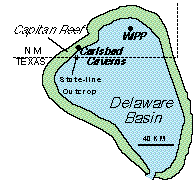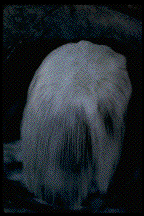
Looking for WIPP
In 1972 Geologists selected a site for the WIPP disposal
project which lay within the Delaware Basin in southeastern New Mexico,
not too far from Carlsbad Caverns.
This was the place that, years earlier, I had unwittingly adopted as my own. The WIPP project hit a snag when a gusher of gas and brine erupted from a test borehole. Because I had studied the basin,I was asked to be a consultant. The brine was in a geologic formation made of many thousands of thin layers of dark calcite and thicker layers of pure, nearly white gypsum. Each pair or couplet of light and dark layers had been deposited in one year's time, and like tree rings, the layers recorded changes in climate.


Left: Brine bubbling up from the Castile. Right: Light/dark
couplets in the Castile.
My students and I had set out to measure each layer and to
put together what was to become the world's longest annual record of climate
change - a quarter million years. While we were collecting the layers, about
10 years before the WIPP project began, my student and friend, Walter Dean
and I had drilled into a similar chamber of gas and found brine (see above)
not too many miles away.
I was being asked to use my knowledge of the geologic basin to help solve
the mystery of the brine.
We never really solved the mystery, and eventually, the site was abandoned,
and another site was chosen eight miles farther to the west. For the next
five years I worked as part of the exploration team at the second site.
But investigations at the new site showed that a chamber of brine and gas
probably lay beneath the repository. We we parted company when WIPP science
managers denied that a brine reservoir could be beneath the repository.